Rushuang Zhou
Computation-Efficient Semi-Supervised Learning for ECG-based Cardiovascular Diseases Detection
Jun 20, 2024Abstract:Label scarcity problem is the main challenge that hinders the wide application of deep learning systems in automatic cardiovascular diseases (CVDs) detection using electrocardiography (ECG). Tuning pre-trained models alleviates this problem by transferring knowledge learned from large datasets to downstream small datasets. However, bottlenecks in computational efficiency and CVDs detection performance limit its clinical applications. It is difficult to improve the detection performance without significantly sacrificing model computational efficiency. Here, we propose a computation-efficient semi-supervised learning paradigm (FastECG) for robust and computation-efficient CVDs detection using ECG. It enables a robust adaptation of pre-trained models on downstream datasets with limited supervision and high computational efficiency. First, a random-deactivation technique is developed to achieve robust and fast low-rank adaptation of pre-trained weights. Subsequently, we propose a one-shot rank allocation module to determine the optimal ranks for the update matrices of the pre-trained weights. Finally, a lightweight semi-supervised learning pipeline is introduced to enhance model performance by leveraging labeled and unlabeled data with high computational efficiency. Extensive experiments on four downstream ECG datasets demonstrate that FastECG not only outperforms the state-of-the-art methods in multi-label CVDs detection but also consumes fewer GPU footprints, training time, and parameter storage space. As such, this paradigm provides an effective solution for achieving high computational efficiency and robust detection performance in the clinical applications of pre-trained models under limited supervision.
Semi-Supervised Learning for Multi-Label Cardiovascular Diseases Prediction:A Multi-Dataset Study
Jun 18, 2023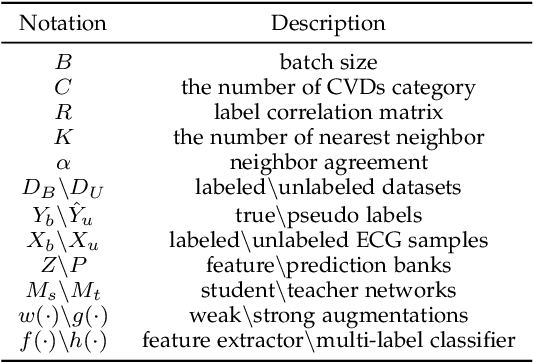
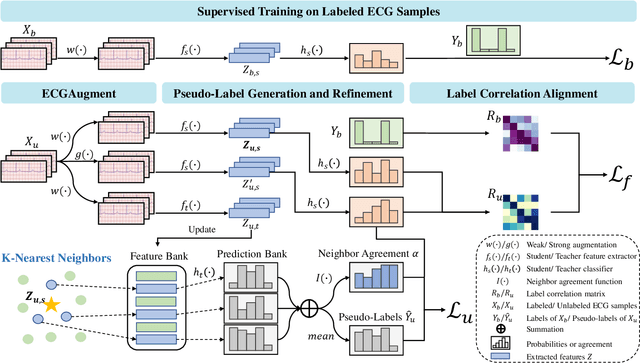
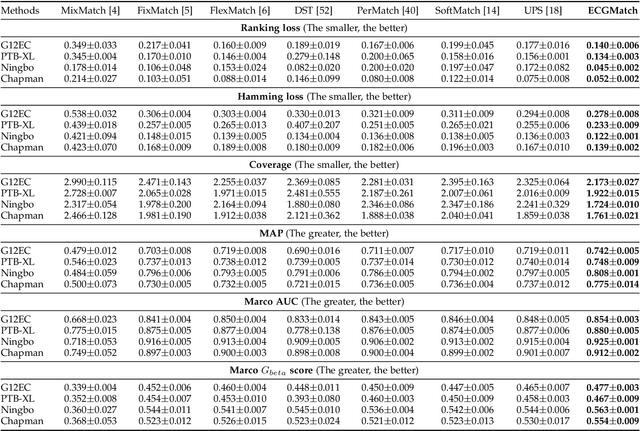
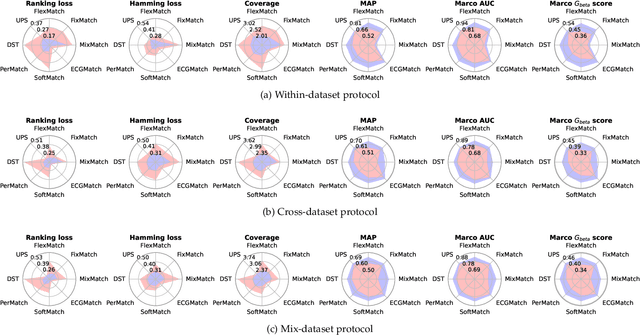
Abstract:Electrocardiography (ECG) is a non-invasive tool for predicting cardiovascular diseases (CVDs). Current ECG-based diagnosis systems show promising performance owing to the rapid development of deep learning techniques. However, the label scarcity problem, the co-occurrence of multiple CVDs and the poor performance on unseen datasets greatly hinder the widespread application of deep learning-based models. Addressing them in a unified framework remains a significant challenge. To this end, we propose a multi-label semi-supervised model (ECGMatch) to recognize multiple CVDs simultaneously with limited supervision. In the ECGMatch, an ECGAugment module is developed for weak and strong ECG data augmentation, which generates diverse samples for model training. Subsequently, a hyperparameter-efficient framework with neighbor agreement modeling and knowledge distillation is designed for pseudo-label generation and refinement, which mitigates the label scarcity problem. Finally, a label correlation alignment module is proposed to capture the co-occurrence information of different CVDs within labeled samples and propagate this information to unlabeled samples. Extensive experiments on four datasets and three protocols demonstrate the effectiveness and stability of the proposed model, especially on unseen datasets. As such, this model can pave the way for diagnostic systems that achieve robust performance on multi-label CVDs prediction with limited supervision.
EEGMatch: Learning with Incomplete Labels for Semi-Supervised EEG-based Cross-Subject Emotion Recognition
Mar 27, 2023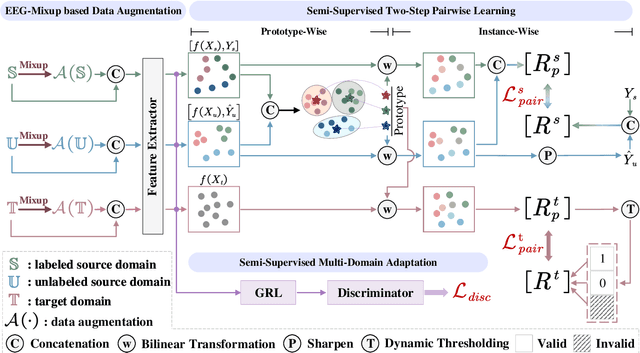


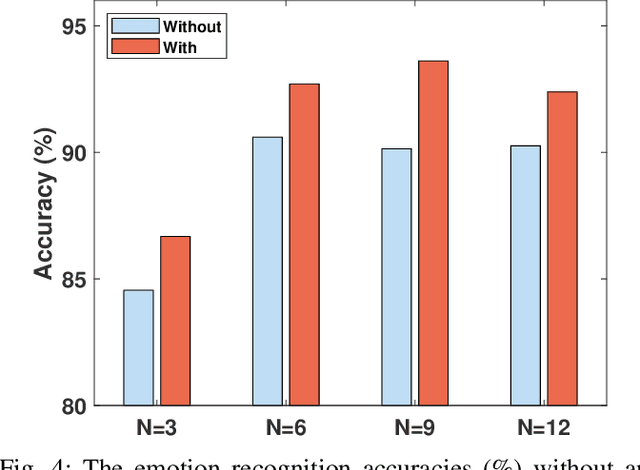
Abstract:Electroencephalography (EEG) is an objective tool for emotion recognition and shows promising performance. However, the label scarcity problem is a main challenge in this field, which limits the wide application of EEG-based emotion recognition. In this paper, we propose a novel semi-supervised learning framework (EEGMatch) to leverage both labeled and unlabeled EEG data. First, an EEG-Mixup based data augmentation method is developed to generate more valid samples for model learning. Second, a semi-supervised two-step pairwise learning method is proposed to bridge prototype-wise and instance-wise pairwise learning, where the prototype-wise pairwise learning measures the global relationship between EEG data and the prototypical representation of each emotion class and the instance-wise pairwise learning captures the local intrinsic relationship among EEG data. Third, a semi-supervised multi-domain adaptation is introduced to align the data representation among multiple domains (labeled source domain, unlabeled source domain, and target domain), where the distribution mismatch is alleviated. Extensive experiments are conducted on two benchmark databases (SEED and SEED-IV) under a cross-subject leave-one-subject-out cross-validation evaluation protocol. The results show the proposed EEGmatch performs better than the state-of-the-art methods under different incomplete label conditions (with 6.89% improvement on SEED and 1.44% improvement on SEED-IV), which demonstrates the effectiveness of the proposed EEGMatch in dealing with the label scarcity problem in emotion recognition using EEG signals. The source code is available at https://github.com/KAZABANA/EEGMatch.
EEGFuseNet: Hybrid Unsupervised Deep Feature Characterization and Fusion for High-Dimensional EEG with An Application to Emotion Recognition
Feb 07, 2021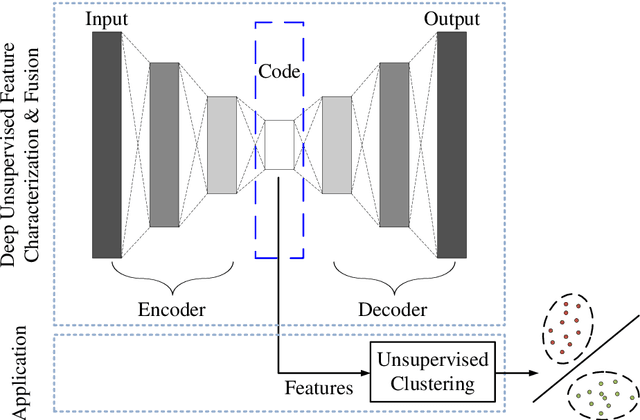
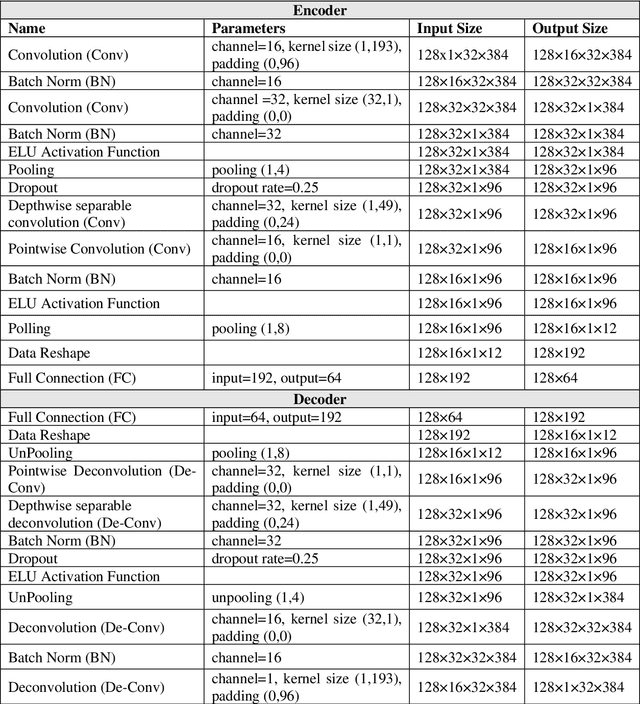
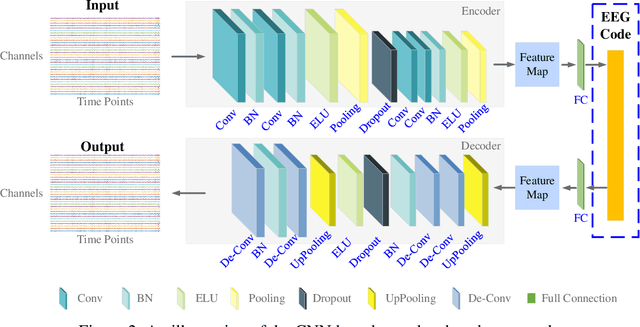
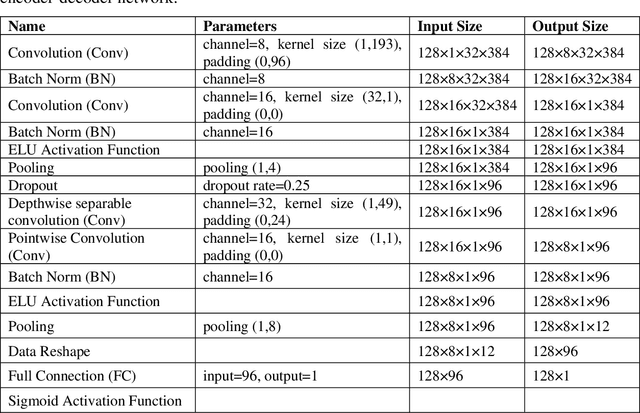
Abstract:How to effectively and efficiently extract valid and reliable features from high-dimensional electroencephalography (EEG), particularly how to fuse the spatial and temporal dynamic brain information into a better feature representation, is a critical issue in brain data analysis. Most current EEG studies are working on handcrafted features with a supervised modeling, which would be limited by experience and human feedbacks to a great extent. In this paper, we propose a practical hybrid unsupervised deep CNN-RNN-GAN based EEG feature characterization and fusion model, which is termed as EEGFuseNet. EEGFuseNet is trained in an unsupervised manner, and deep EEG features covering spatial and temporal dynamics are automatically characterized. Comparing to the handcrafted features, the deep EEG features could be considered to be more generic and independent of any specific EEG task. The performance of the extracted deep and low-dimensional features by EEGFuseNet is carefully evaluated in an unsupervised emotion recognition application based on a famous public emotion database. The results demonstrate the proposed EEGFuseNet is a robust and reliable model, which is easy to train and manage and perform efficiently in the representation and fusion of dynamic EEG features. In particular, EEGFuseNet is established as an optimal unsupervised fusion model with promising subject-based leave-one-out results in the recognition of four emotion dimensions (valence, arousal, dominance and liking), which demonstrates the possibility of realizing EEG based cross-subject emotion recognition in a pure unsupervised manner.
 Add to Chrome
Add to Chrome Add to Firefox
Add to Firefox Add to Edge
Add to Edge